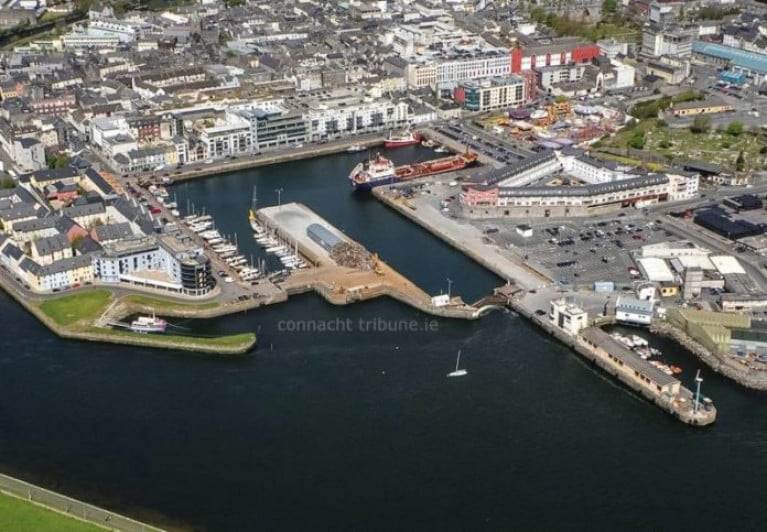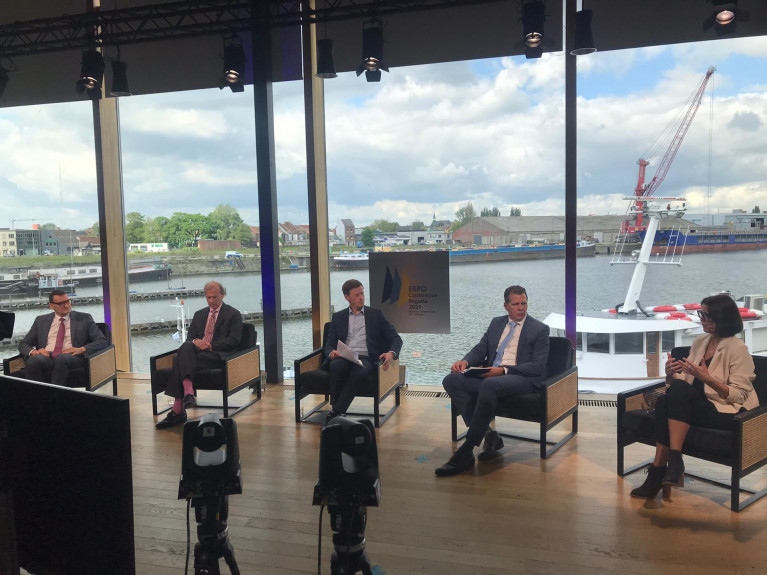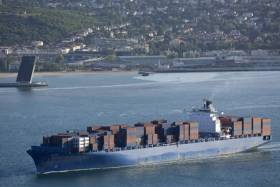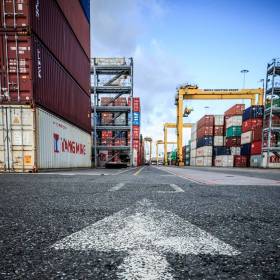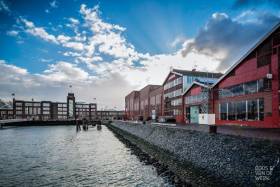Displaying items by tag: TENT
An increase in EU funding for Galway Port has been pushed for following a series of meetings in Brussels this week.
The meetings, facilitated by MEP for this region Colm Markey, took place between port representatives, officials from the European Commission and a number of MEPS.
The focus was on potential funding streams for the planned redevelopment of Galway Port, with a focus on supporting offshore wind capacity.
Advocates say the North-West has the best wind speeds in Europe, but it is the only maritime region not included in the Trans European Transport Network.
Connacht Tribune also has a podcast from the port's CEO and the role of TEN-T.
In the upcoming review of TEN-T guidelines, they have been one of the central topics during the first two days of the European Sea Ports Organisation (ESPO) Conference Regatta 2021.
European Transport Commissioner Adina Vălean, Motorways of the Sea (MoS) Coordinator Prof. Kurt Bodewig, Members of the European Parliament and port representatives presented and discussed their views and expectations of the upcoming review of Europe’s transport infrastructure policy.
“During the discussions with EU policy makers we have seen a clear recognition of the role of Europe’s seaports and a clear understanding that this should be translated in a policy that strengthens both the sustainability and resilience of the maritime and port sector, while addressing the needs in basic infrastructure and port connectivity. This very much aligns with our ESPO position where we call for a level playing field of the land-based and the maritime dimension of Europe’s transport network and for a recognition of the strategic and diverse role of ports. As gateways to the world, being at the crossroads of supply chains, as hubs of energy, industry and blue economy, ports can substantially contribute to a sustainable, digital and resilient European recovery,” says ESPO’s Secretary General Isabelle Ryckbost.
In her opening address to the ESPO Conference Regatta, European Transport Commissioner Vălean said: “Our ambition is to better integrate maritime links in the TEN-T as part of the logistic chain for obvious reasons related to decarbonisation and efficiency. In addition, we want to better connect maritime links of the core network with rail freight corridors and better integrate the Motorways of the Sea programme within the TEN-T policy.”
During his intervention, Motorways of the Sea Coordinator Prof. Bodewig approached the MoS concept as a sustainable, smart and seamless European Maritime Space, but acknowledged that in addition to these three pillars, resilience will play a central role for the European transport system. Increased resilience of the overall transport system requires a stronger maritime dimension, including more and new maritime connections, as well as the development of port infrastructure.
“A strong and resilient maritime sector is key to ensure a sustainable development and competitiveness of the European economy. I strongly advocate investments in fleet renewals, alternative fuels and last-mile connections to the TEN-T,” remarked the MoS Coordinator Prof. Bodewig.
Motorways of the Sea (MoS) Coordinator Prof. Bodewig during the ESPO Conference Regatta 2021
In his key note speech, EIB Vice President Kris Peeters emphasised: “We should still invest in basic infrastructure, but it is important to consider the value for the supply chains.”
In the lead-up to the Conference Regatta, the European Sea Ports Organisation had adopted a joint position on the TEN-T revision (enclosed), focusing on the following 11 points:
- The changing role of ports
- Basic infrastructure needs remain, but additional diverse infrastructure needs come on top
- The main goals of EU transport infrastructure policy
- A strong maritime dimension: levelling the playing field
- Greening the TEN-T network
- Adjustment of the network
- Ports as strategic nodes
- Last-mile a first priority
- European seaports are critical for a resilient transport system
- Enhancing the digitalisation of the port ecosystem
- Policy coherence and synergies
The full position can be found here.
Review of TEN-T Policy Must Bring Maritime Links on Equal Footing With Land Links
A process has begun at the European Commission for reviewing the 2013 TEN-T guidelines with a public consultation before next summer.
The European Sea Ports Organisation (ESPO) believes the review should not lead to a complete change of direction in the TEN-T policy. The rationale of the 2013 guidelines remains the same: achieving an efficient, sustainable and multimodal Transport Infrastructure Network in Europe.
ESPO, however believes that the European Commission should use the review as an opportunity to level the playing field between the maritime and the land links.
“More than 30 % of intra EU freight traffic is currently going over sea. The ongoing digitalisation, the progress on the internal market for maritime transport with the new European Single Window Environment framework and the greening of shipping, which seems to be delivering first on the short sea links, will give maritime transport within the EU, and even within one Member State, a new impetus. It is now time to fully recognise the contribution of maritime transport to the aims of Europe’s Transport Infrastructure policy. The maritime dimension must be brought on an equal footing with the land-based corridors and links,” says ESPO’s Secretary General Isabelle Ryckbost.
More concretely, ESPO refers to the following discrepancies between the maritime and the land network:
- The TEN-T guidelines are currently only recognising maritime links between two Member States as TEN-T short sea links, the so-called Motorways of the Sea. The links between two ports within one Member State are not considered as Motorways of the Sea, whereas the TEN-T road or rail network is also recognising the national stretches as part of the TEN-T network.
- Even if seaports are in most cases situated on the territory of one Member State, they are a part of the maritime border of a country. Being the gateway for trade with other EU member states and third countries, maritime ports must be seen as cross-border entities or sections. Moreover, also in their hinterland, ports are serving a catchment area that largely exceeds the local or national borders.
The full contribution of ESPO to the public consultation on the review of the Regulation 1315/2013 on Union Guidelines for the Development of the Trans-European Transport Network can be found here.
TEN-T Review Must Recognise the New Roles of Ports
The European Commission before summer kicked off the review of the TEN-T Regulation 1315/2013 with a public consultation. The European Sea Ports Organisation (ESPO) submitted its proposals for the review.
“European ports remain strong supporters of the 2013 Europe’s Transport Infrastructure Policy, which literally put the seaports on the TEN-T map. It is now time to adapt the framework to the new market realities, new challenges and new needs. Looking in a more comprehensive way at what ports can do, not only for transport, but also in terms of decarbonisation of society and digitalisation of supply chains and having that mirrored in the guidelines, is one of the to-do’s in this review. Nowadays ports are much more than a component of maritime transport, they have a pivotal role between the different modes and the different networks”, says ESPO’s Secretary General Isabelle Ryckbost.
For European ports, the review must be used, above all, as an opportunity to update the TEN-T network in relation to new market realities (such as volume growth, scale increases); new societal challenges (climate, air pollution, noise, increasing urbanisation); new needs (digitalisation, automation, e-commerce); and as a consequence, the changing role of European ports.
ESPO believes that seaports are more than a “component of maritime transport infrastructure”. The new TEN-T guidelines should be adapted to recognise the role many seaports are playing as strategic multimodal nodes, nodes of energy and digital hubs on top of their classical role as components of maritime transport infrastructure. Their unique role makes each European port a strategic partner in responding to today’s main challenges of decarbonisation and digitalisation.
Moreover, over the last years, European ports have been increasingly involved in a process of cooperation, clustering and merging, both bottom-up and top-down. The new TEN-T policy should take into account and encourage these developments in the port sector. European ports believe that port clusters have to be clearly defined in the framework of the future TEN-T policy. While the clustering should not change the initial identification of “core” and “comprehensive” ports, individual projects should be assessed in terms of their relevance for the cluster and thus the network as such.
ESPO stresses the importance of Motorways of the Sea (MoS) as an integral and important part of the TEN-T network and believes that the maritime dimension should be considered equally important as the land-based TEN-T corridors. In order to use the full potential of the network’s maritime links, short sea shipping should be strongly facilitated as an equally important transport mode for intra-European transport next to the other transport modes. In that regard, MoS requirements should be reviewed and the maritime links between two countries should be fully acknowledged and prioritised as cross-border.
Finally, ESPO points out that the deadlines for realising the core and comprehensive TEN-T network can only be met with the full support of Member States, and if the engagement of the Union and its Member States comes with a corresponding budget. ESPO’s study on the investment needs of European ports has revealed that the ports’ investment needs amount to 48 billion EUR over the next ten years. In the period 2014-2017, port managing bodies have only been able to obtain 4% of the CEF transport budget.
The Public Consultation on the review will be followed by an evaluation study and other targeted consultations. The Commission proposal for a revision is planned for the first semester of 2021.
To read the full position (download pdf) here.
ESPO Calls on EU Parliament & Member States to Support Transport Budget Proposal Under New CEF
#Ports&Shipping- The European Commission proposal for the Multi Annual Financial Framework 2021-2027 adopted on Wednesday, reserves a similar budget for the Connecting Europe Facility, the financial instrument for Transport, in the current financial period.
The proposal foresees 12,8 billion EUR under the general envelope, 11,3 billion EUR for transport projects in Cohesion countries and a new envelope of 6,5 billion EUR for investments in transport infrastructure for dual civilian-military use.
For the European Sea Ports Organisation (ESPO), the allocation within the MFF proposal clearly shows the support of CEF as a financial instrument and proves that the Commission, and in particular the Budget Commissioner Günther Oettinger, is recognising the high added value of transport investments in terms of growth, jobs and sustainability.
"We certainly welcome the Commission proposal, but we know that there is still a long way to go. Both the Parliament and Council will have to support this proposal, we cannot allow further cuts. We must now convince the MEPS and the Member States that the CEF Transport budget is serving all sectors and all policies, not only the transport sector as such. We should also convey the message that this budget serves to realise the TEN-T network, an already well identified plan with concrete priorities,” says Isabelle Ryckbost, ESPO’s Secretary General.
While the MFF budget proposal is received positively, European ports believe a lot will nevertheless depend on the concrete layout of the new Connecting Europe Facility proposal due to come out on 6th June. It also remains to be seen how the new military component, which receives a substantial part of the CEF transport budget, will serve the actual investment needs of ports.
“If Europe wants to achieve a fully-fledged and operational TEN-T network, more attention must be given to ports. European ports play an increasingly important role in the transport chain and for the European economy, as they have developed into important nodes of energy, industry and blue economy in addition to their traditional maritime transport role. They can also play an important role in the decarbonisation of the European economy. It is time for Europe to recognise the strategic role of ports and to support their investments accordingly,” adds Isabelle Ryckbost.
A study, commissioned by the European Sea Ports Organisation investigating the future investment needs of European ports, estimates that European ports face investment needs of around 48 € billion for the period 2018-2027. It also shows that port authorities have only been able to obtain 4 percent of the grant envelope over the last four years.
ESPO is looking forward to discuss the European budget and the forthcoming CEF proposal with the responsible DG MOVE Director Herald Ruijters, the European Parliament and the TEN-T Coordinators at its upcoming Conference in Rotterdam, on 31 May and 1 June.
For information about the conference can be found on www.espo-conference.com


























